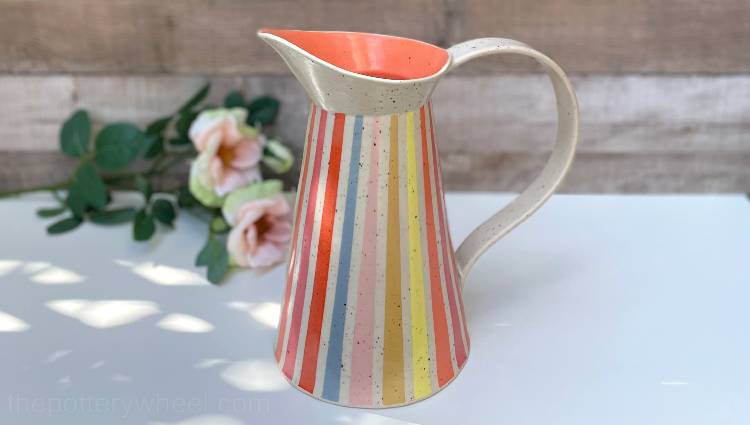Your cart is currently empty!
Is Stoneware Oven Safe? – Using Ceramics in the Oven
Published:
Last Updated:
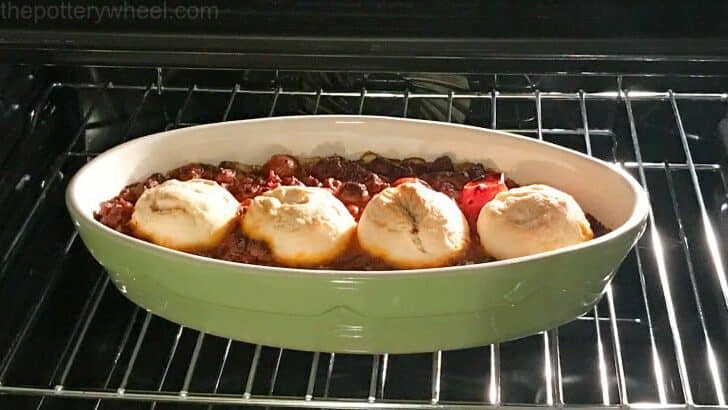
Affiliate Disclaimer
As an affiliate, we may earn a commission from qualifying purchases. We get commissions for purchases made through links on this website from Amazon and other third parties.
Stoneware is a very durable ceramic material and lots of kitchenware and dinnerware are made out of it. It’s great for prepping and serving food. But if you like to bake or roast, you may well be wondering if stoneware is oven safe too.
Most stoneware dishes are oven safe. In fact, stoneware is often used to make pie dishes, baking trays, and casserole dishes designed to go in the oven. Often stoneware can be used in the oven up to 350F, but some brands are safe at higher temperatures such as 450F.
That being said, not all stoneware is oven safe. And even when stoneware is suitable for the oven, certain guidelines need to be followed. For more details about what stoneware can be used in the oven, and how to bake or roast with it safely, read on…
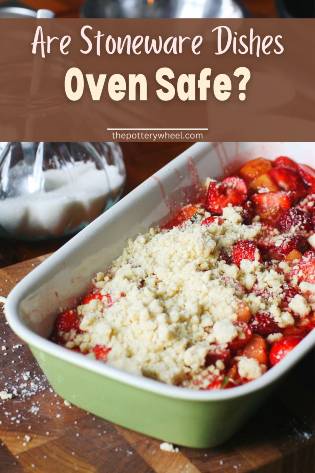
How to Tell if Your Stoneware is Oven Safe
First, let’s take a quick look at what it means to be oven safe. The term oven safe is often used interchangeably with ‘oven proof’. And the definition of being ovenproof is to be able to withstand “the temperature range of a kitchen oven” (source).
The main worry when putting ceramics in the oven is that the dish will crack or shatter in the heat. So, how do you tell if your stoneware is oven safe?
Generally, a reputable and contemporary ceramics manufacturer will label their dishes as oven safe if they can be used for cooking and baking.
The label will either read ‘oven proof’ or ‘oven safe’ or there will be a symbol underneath to say if the dish can be used in the oven. An oven safe symbol will look something like this, though the design may vary between brands.
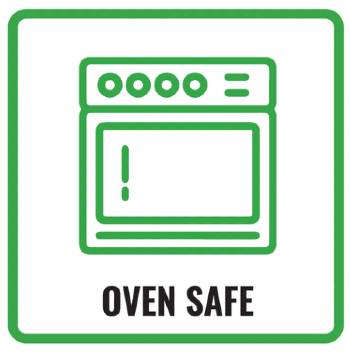
However, not all stoneware will be labeled as oven safe. If you own a piece that is not marked in this way, then it’s best to reach out to the manufacturer first and check with them.
Usually, if the manufacturer is still in business they will have a customer services department that will answer your query.
What if Your Stoneware is Not Labeled?
Sometimes you will own some stoneware that doesn’t have any markings on the base. Or you might have a piece of vintage stoneware that you inherited down the family line. A lot of older stoneware won’t state whether a dish can be used in the oven or not.
If you don’t know who made the item, or if the dish is old or antique, then it is advisable to avoid using it in the oven.
Different types of stoneware can tolerate being cooked at different temperatures. And if you don’t know the make or type of stoneware, it’s a gamble to put it in the oven. I will say a bit more about vintage stoneware later. If you are particularly interested in whether you can cook in antique stoneware, you can jump to that section here.
Why is Most Stoneware Oven Safe?
Stoneware has 4 special features that help it cope well with the heat involved in oven cooking.
Feature 1) How Stoneware is Made
Different types of dishes and kitchenware are made out of different types of clay. There are three main types of clay, earthenware, porcelain, and stoneware clay.
When ceramics are being made, the clay is formed into the shape needed, be it a plate, dish, or bowl. Once the clay is formed, it is fired in a kiln.
A kiln is essentially a large oven that heats up to very high temperatures. Firing is a little like baking the clay, at red or orange hot temperatures. If you would like to know more about exactly how kilns work you can check out my guide to kilns here.
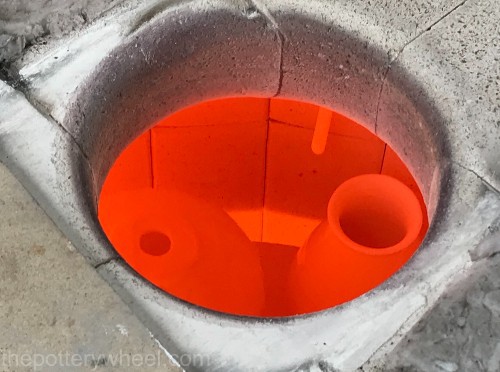
Different types of clay need to be fired at different temperatures. For example, earthenware clay is fired in the lower temperature range. By contrast, stoneware and porcelain are fired at higher temperatures.
Stoneware dishes are made out of, you guessed it, stoneware clay. And the correct firing range for stoneware clay is between 2185F (1196C) and 2232F (1222C). In fact, some stoneware is fired at 2381F (1305C).
These temperatures are well in excess of the temperature of an ordinary domestic oven. So, during its production, the stoneware will have survived much higher temperatures than you could reach in a home oven.
Feature 2) Stoneware is Non-Porous
One of the advantages of stoneware ceramics is that, if it’s well made, it will be non-porous.
This means that when it is washed it will not absorb water. It also means that when you are cooking food in it that contains liquid, it will not absorb sauces from the food.
Being non-porous is an advantage when you are cooking in the oven. When water reaches 212F (100C) it turns to steam. As it turns to steam, water expands rapidly in volume.
If your ceramic dinnerware has absorbed water, that water can evaporate into steam as the oven heats up. As the steam expands, this puts internal pressure on the ceramic ware. And the internal pressure can either weaken the ceramics or it can actually cause them to crack or break.
Because stoneware is non-porous, this danger is avoided.
Feature 3) Stoneware Holds its Heat
Stoneware ceramics don’t cool down quickly and they hold their heat. This means that you can take the dish out of the oven and use it to keep the food warm whilst you are serving up and eating.
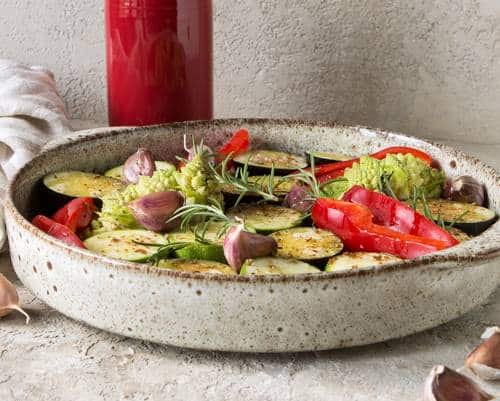
Just be mindful not to put the hot stoneware down on a cold surface. Instead, place it onto a suitable trivet. This will protect your counter and it will also protect the ovenware from coming into contact with a cold work surface.
Feature 4) Stoneware is Tough and Durable
Another feature of stoneware clay that makes it a good option for ovenware is that it is strong and durable.
When stoneware is fired during manufacture, the stoneware clay becomes very dense and strong. The glaze on the outside of the stoneware forms a tough glassy surface that is bonded very thoroughly to the underlying ceramic body.
This means that stoneware oven dishes will survive the inevitable knocks and bumps involved in everyday cooking activities.
Does That Mean that Stoneware is Invincible?
Although stoneware is fired at much higher temperatures, the temperature of the kiln is very carefully managed. And the firing process is handled carefully.
Just because it was fired to a very hot temperature in a kiln, doesn’t mean that a stoneware dish will survive any kind of treatment in an oven.
There are ways of looking after your stoneware that will help to prevent it from being damaged through oven usage. Here are some tips on how to use your stoneware in the oven…
Tips for Using Stoneware in the Oven
If you want to use stoneware in the oven, here are some guidelines usually recommended by manufacturers…
Tip 1 – Is it Labeled Oven Safe?
The first and most obvious suggestion is to check the underside of the dish to see if it has an ‘oven-safe’ label. As mentioned above, a lot of oven safe stoneware will be labeled as such by the manufacturer.
Tip 2 – Check the Maximum Cooking Temperature
If the dish is labeled ‘oven safe’, check in the user manual or online to see what the maximum temperature is that it can cope with. I have created a table below with some information about different brands and maximum suitable temperatures. You can jump to that section here.
Tip 3 – Avoid Sudden Temperature changes
When stoneware is subjected to a sudden temperature it puts the ceramic material under a lot of internal tension. This can cause the item to crack or break from the stress (source).
In general, it’s best to avoid taking a stoneware dish directly from the fridge and then putting it directly into a preheated oven. Ideally, it’s better to let the dish become room temperature before putting it in a preheated oven.
You may get away with taking your dish from the fridge and putting it in a hot oven. But you should always avoid removing stoneware from the freezer and putting it in a preheated oven.
Stoneware is usually safe to put in the freezer. However, most ovenware manufacturers advise removing dishes from the freezer and allowing them to thaw completely before putting them in the oven.
In the same vein, it’s usually recommended that you don’t place large pieces of dense frozen food like a chicken or joint of meat onto stoneware and then put it in a preheated oven.
The temperature differential between the frozen food and the oven can be enough to cause thermal shock.
It is ok to put smaller pieces of frozen food such as chicken nuggets on a stoneware dish and then put it in a preheated oven. Just be sure to spread the pieces of frozen food out evenly across the dish rather than piling them high (source).
There are Some Exceptions
That being said, different manufacturers of stoneware will have slightly different recommendations about how to handle temperature changes. So, it’s always best to refer back to their specifications.
For example, cookware made by Emile Henry is made to be able to withstand extreme temperature changes. As such, it can be taken from the freezer and put directly into a hot oven (source).
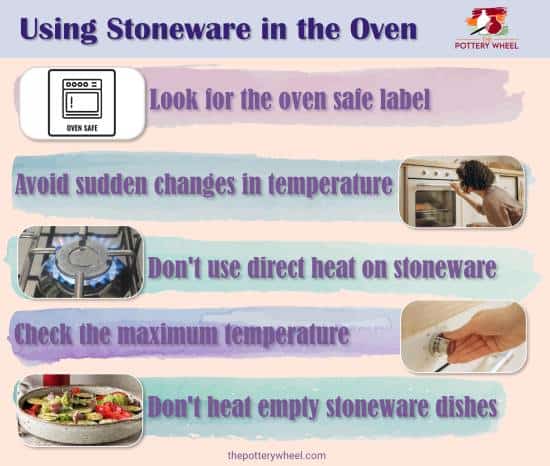
Tip 4 – Don’t Heat an Empty Stoneware Dish in the Oven
If you put an empty stoneware dish in the oven, the heat in the oven will be directed entirely at the ceramic material. This can cause the dish to break or crack.
It’s important to always have food in the dish when it’s in a hot oven. Ideally, the dish should be just a bit larger than the food that is being heated. Most of the base of the dish needs to be covered with food. And it’s often recommended that the dish is two-thirds full.
The point is, that it’s better not to have a single isolated chicken breast in the middle of a large stoneware dish. If most of the dish is empty, there is a risk that the dish may break as you cook.
Tip 5 – Don’t Use Stoneware ‘On or Under’ Direct Heat
The heat in an oven is evenly distributed over your stoneware. For that reason, one part of your dish will become much hotter than another.
However, if heat is directed at your ovenware in an uneven way, then this can put a lot of strain on the ceramic material. As the dish heats up, it expands. If one part of the dish is heating and expanding, and another part is remaining cool then the dish is put under a lot of stress.
This can cause the stoneware to crack or shatter. This is why it’s not recommended that you heat your food in stoneware using direct heat from a stove, hob, grill, or broiler.
The intense heat from each of these sources tends to concentrate on one particular area of the dish. This puts the dish under a lot of strain. Some stoneware manufacturers do make a few items that are suitable to be used under a broiler.
For example, Le Creuset stoneware can be used under the broiler. However, they do recommend that the dish be kept at least 2.5 inches away from the heat source, for the reasons outlined above (source).
Is All Stoneware Oven Safe?
Most stoneware is oven safe, however, there are a few things to watch out for. Some indicators that you may not be able to use your stoneware in the oven include the following…
Factor 1) Is the Stoneware Handmade?
The majority of stoneware that is made commercially these days will have a label on the underside to state whether it is oven safe or not.
If the label is not evident, you will likely be able to check with the manufacturer or user manual to find out whether it’s oven safe and if so, what the maximum temperature is.
This is not always the case with stoneware ceramics that have been handmade by an individual potter. If you have bought your handmade pottery from an online store like Etsy, then you can always reach out to the potter and double-check if it’s oven safe.
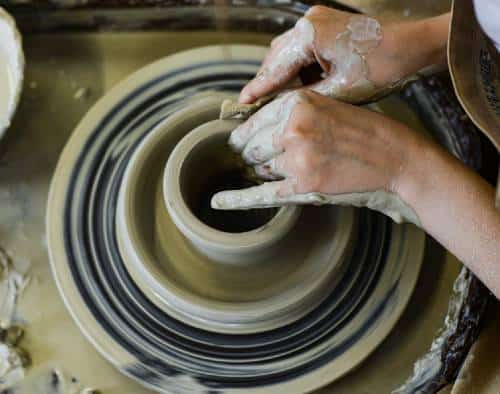
However, there are circumstances where you may not be able to check with the maker. For example, the stoneware pottery may have been given to you as a gift. Or perhaps you picked it up at a thrift store.
If you don’t know who made the ceramics and there is no label on the dish, then it’s a gamble using it in the oven. There are a couple of things that may cause problems,
The first thing to consider is that you don’t know what temperature the potter fired the stoneware at. If the pottery was not fired at a hot enough temperature when it was being made, then it may be weak and porous.
Weakness or porosity would make the stoneware vulnerable to cracking in the heat of the oven.
A second issue is connected to the glaze that may have been used by the potter to glaze the item. Let’s take a look at the issue of glaze now…
Factor 2) What Glaze Has Been Used?
In the past, lead was a commonly used ingredient in ceramic glazes. However, there has been increased concern over the years around the leaching of heavy metals from ceramic glazes into food. And the presence of lead and cadmium is now regulated.
Commercial manufacturers are now legally obliged, to use lead free glazes when making ceramics that will be used for food and drink (source).
This lovely Minton Chestnut server made in 1865 was lead glazed and would no longer meet required regulations.
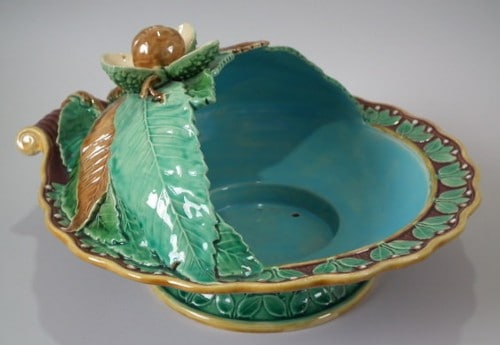
Some glazes do still contain lead, however, these are not used for the production of dinnerware and ovenware.
There is still some concern about ceramic products that have been imported from countries that are not regulated in the same way. For example, the FDA wrote a report on the discovery of toxic levels of lead being transferred from imported Mexican pottery into food and drink.
Regulations have now been put in place to ensure that imported ceramics intended for food and drink do not present a risk through the leaching of heavy metals into food.
However, it’s hard to regulate what glazes are being used by independent or hobby potters. A potter may make a dish using a glaze that is not food safe. Perhaps the potter made the dish with the intention of it being used for decoration only.
But it may wind up in your kitchen cupboard somehow, for example as a thrift store purchase. The point is, if you don’t know who made the stoneware or how it was made, it’s probably best to avoid using it for food or drink, or indeed in the oven.
Factor 3) Cracked or Damaged Stoneware
Stoneware is strong but it is not indestructible, and it can crack or chip if it is mishandled.
If you notice that your dish is cracked, it’s best not to use it in the oven. The crack can harbor bacteria that might contaminate your food. But also, the crack is a point of weakness and it may open up further in the heat of the oven.
If moisture nestles in the crack and expands when the dish heats in the oven, the stoneware could split along the crack.
Factor 4) Vintage or Antique Stoneware
A related factor is the age of the stoneware dish. Strictly speaking, an item becomes antique when it’s over 100 years old. But the FDA brought in its guidelines about lead levels in ceramics in 1971 (source).
So, if your stoneware was made before the 1970’s it’s good to exercise caution before letting it come into contact with your food or drink.
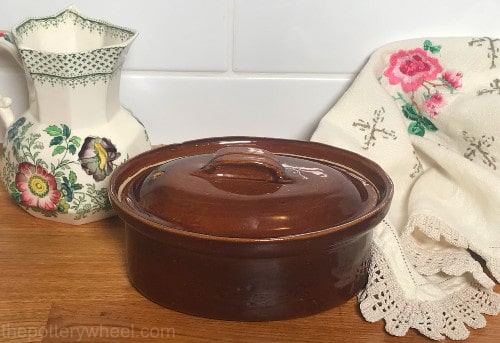
If you know the origins of your antique stoneware and you can research how it was made, then it may be safe to use in the oven. But if there is a question mark over how it was made or glazed, then it’s probably advisable to oven-cook your meal in a different dish.
Factor 5) Is the Stoneware Glazed or Unglazed?
You can use unglazed stoneware in the oven. However, before you cook with it you do need to season the unglazed stoneware to seal it.
There are different approaches to seasoning unglazed ceramics. However, a simple technique is to wash the unglazed stoneware with a scrubbing brush, without using soap.
Dry the dish with a lint-free cloth or towel. Then rub some vegetable oil into the unglazed surface of the dish.
Put the stoneware into an oven and heat at 400F for 20 minutes to half an hour. Then turn the oven off and allow the dish to cool in the oven.
With usage, the dish will become more seasoned, especially if you are cooking oily or fatty foods. Unglazed and seasoned ovenware will become darker and discolored with further usage. However, this is normal and is an indication that the dish is well-seasoned.
How Hot Can the Oven be for Stoneware?
The table below indicates the temperatures that some brands of stoneware can cope with in the oven. I’ve included items alphabetically so you can find brands you are interested in easily.
Where I can I’ve included a link to some items that can be heated to the temperature specified.
Do remember that different items made by the same manufacturer may tolerate different temperatures. It’s always a good idea to double-check the user guidelines or the maker’s website first for information about a particular range of stoneware items.
For example, different items of Pfaltzgraff stoneware each have specific maximum oven temperatures ranging from 350-500F.
Also, these temperatures refer to stoneware that is designed to go in the oven, eg bakeware, pie dishes, and casserole dishes. It does not include stoneware plates, platters, or serving dishes.
That being said, it’s helpful to compare the different temperatures that stoneware can be heated up to.
Final Thoughts
There are many features that make stoneware oven safe. If you own some stoneware and you want to use it for baking or roasting, chances are you will be fine. However, it’s always good to do a bit of due diligence before you start cooking. I hope the information above will help you get cooking with confidence in your choice of ceramic ware.

